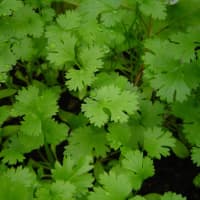Cilantro (Coriandrum sativum)
Biological Properties
Antiinflammatory
Anticonvulsant
Cilantro extract is highly effective at activating multiple isoforms within a clinically prominent family of human Voltage-gated potassium channels.[1]
Wound Healing
Cilantro oil and its major active component, linalool, have been reported to possess anti‐inflammatory and wound healing properties.[2]
Disease / Symptom Treatment
Cardiovascular Disease
Heart Faliure
Cilantro extract improves left ventricular function after heart failure.[1:1]
- The potassium channel–activating ability of cilantro extract has been shown to help to repolarize ventricular cardiomyocytes.[1:2]
Neurological Disorders
Seizures
Cilantro leaf harbors a potent potassium channel–activating anticonvulsant.[1:3]
Study Type: Human Study: In Silico
Title: Cilantro leaf harbors a potent potassium channel–activating anticonvulsant
Author(s): Rían W. Manville and Geoffrey W. Abbott
Institution(s): Bioelectricity Laboratory, Department of Physiology and Biophysics, School of Medicine, University of California–Irvine, Irvine, California, USA
Publication: Federation of American Societies For Experimental Biology (FASEB)
Date: July 2019
Abstract: Herbs have a long history of use as folk medicine anticonvulsants, yet the underlying mechanisms often remain unknown. Neuronal voltage-gated potassium channel subfamily Q (KCNQ) dysfunction can cause severe epileptic encephalopathies that are resistant to modern anticonvulsants. Here we report that cilantro (Coriandrum sativum), a widely used culinary herb that also exhibits antiepileptic and other therapeutic activities, is a highly potent KCNQ channel activator. Screening of cilantro leaf metabolites revealed that one, the long-chain fatty aldehyde (E)-2-dodecenal, activates multiple KCNQs, including the predominant neuronal isoform, KCNQ2/KCNQ3 [half maximal effective concentration (EC50), 60 ± 20 nM], and the predominant cardiac isoform, KCNQ1 in complexes with the type I transmembrane ancillary subunit (KCNE1) (EC50, 260 ± 100 nM). (E)-2-dodecenal also recapitulated the anticonvulsant action of cilantro, delaying pentylene tetrazole-induced seizures. In silico docking and mutagenesis studies identified the (E)-2-dodecenal binding site, juxtaposed between residues on the KCNQ S5 transmembrane segment and S4-5 linker. The results provide a molecular basis for the therapeutic actions of cilantro and indicate that this ubiquitous culinary herb is surprisingly influential upon clinically important KCNQ channels.—Manville, R. W., Abbott, G. W. Cilantro leaf harbors a potent potassium channel–activating anticonvulsant.
Link: Source
Citations: ↩︎ ↩︎ ↩︎ ↩︎Title: Efficacy of bergamot: From anti‐inflammatory and anti‐oxidative mechanisms to clinical applications as preventive agent for cardiovascular morbidity, skin diseases, and mood alterations
Author(s): Simone Perna Daniele Spadaccini Leonardo Botteri Carolina Girometta Antonella Riva Pietro Allegrini Giovanna Petrangolini Vittoria Infantino Mariangela Rondanelli
Institution(s): Department of Earth and Environmental Sciences, Mycology and Plant Pathology Laboratory, Pavia, Italy; Department of Biology, College of Science, University of Bahrain, Zallaq, Bahrain; Research and Development Unit, Indena, Milan, Italy; Department of Public Health, Experimental and Forensic Medicine, Section of Human Nutrition, Endocrinology and Nutrition Unit, Azienda di Servizi alla Persona, University of Pavia, Pavia, Italy IRCCS Mondino Foundation, Pavia, Italy
Publication: Food Science & Nutrition
Date: January 2019
Abstract: We summarize the effects of bergamot (extract, juice, essential oil, and polyphenolic fraction) on cardiovascular, bone, inflammatory, skin diseases, mood alteration, anxiety, pain, and stress. This review included a total of 31 studies (20 studies on humans with 1709 subjects and 11 in animals (rats and mice)). In humans, bergamot‐derived extract (BE) exerts positive effects on hyperlipidemia with an oral dose from 150 mg to 1000 mg/day of flavonoids administered from 30 to 180 days, demonstrating an effect on body weight and in modulating total cholesterol, triglycerides, LDL, and HDL. Studies in animals confirm promising data on glucose control (500/1000 mg/day of BE with a treatment lasting 30 days) are available in rats. In animals models, bergamot essential oil (BEO, 10 mg/kg or 20 mg/kg daily for 20 weeks) increases bone volume, decreases psoriatic plaques, increases skin collagen content, and promotes hair growth. Bergamot juice (20 mg/kg) is promising in terms of pro‐inflammatory cytokine reduction. In humans, aromatherapy (from 15 to 30 min) does not appear to be useful in order to reduce stress, anxiety, and nausea, compared to placebo. Compared to baseline, BE topical application and BEO aromatherapy reduce blood diastolic and systolic pressure and could have a significant effect on improving mental conditions.
Link: Source
Citations: ↩︎
